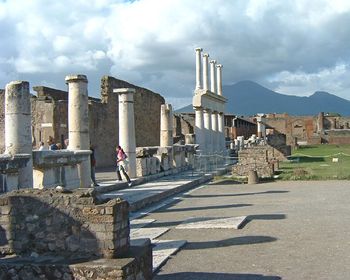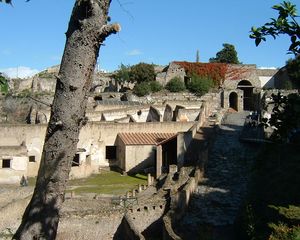Pompeii: Difference between revisions
imported>Richard Nevell (typo) |
imported>Richard Nevell No edit summary |
||
| Line 13: | Line 13: | ||
Campania, the region in which Pompeii is located, is a fertile area on the west coast of Italy. As well as being the most productive agricultural land in Italy, the region was also well positioned for trade. As a result, several Greek colonies were founded in the area, the most important of which were [[Cumae]] (founded in the 8th century B.C.) and Neapolis (now known as [[Naples]] and founded in the 7th century B.C.). In the 7th and 6th centuries B.C. the [[Etruscans]] emerged as a leading power in Campania. This saw them try to conquer Greek colonies and they twice attacked Cumae without success. Archaeologists have recovered Etruscan inscriptions from Pompeii, indicating the town had links to the Etruscans. Historian Michael Grant goes so far as to suggest they may have controlled Pompeii for a while. Etruscan influence waned in the 5th century, and was soon replaced by that of the [[Samnites]]. In 421 B.C. they succeeded where the Etruscans had failed by capturing Cumae, and soon after other Greek colonies in Campania, including Pompeii, fell under their control.<ref>Grant, Michael (1976). '' Cities of Vesuvius: Pompeii & Herculaneum''. pp. 15–20. London: Penguin Books.</ref> | Campania, the region in which Pompeii is located, is a fertile area on the west coast of Italy. As well as being the most productive agricultural land in Italy, the region was also well positioned for trade. As a result, several Greek colonies were founded in the area, the most important of which were [[Cumae]] (founded in the 8th century B.C.) and Neapolis (now known as [[Naples]] and founded in the 7th century B.C.). In the 7th and 6th centuries B.C. the [[Etruscans]] emerged as a leading power in Campania. This saw them try to conquer Greek colonies and they twice attacked Cumae without success. Archaeologists have recovered Etruscan inscriptions from Pompeii, indicating the town had links to the Etruscans. Historian Michael Grant goes so far as to suggest they may have controlled Pompeii for a while. Etruscan influence waned in the 5th century, and was soon replaced by that of the [[Samnites]]. In 421 B.C. they succeeded where the Etruscans had failed by capturing Cumae, and soon after other Greek colonies in Campania, including Pompeii, fell under their control.<ref>Grant, Michael (1976). '' Cities of Vesuvius: Pompeii & Herculaneum''. pp. 15–20. London: Penguin Books.</ref> | ||
[[Ancient Rome|Rome]] in the 4th century B.C. was on the way to establishing itself as the leading power in Italy. The Romans came into conflict with the Samnites, and towards the end of the century Rome succeeded in capturing towns under Samnite control including Pompeii in 310 B.C., and by the turn of the century the region was completely under Roman control. During the [[Punic Wars]] – fought between Rome and [[Carthage]] in the 3rd and 2nd centuries B.C. – Pompeii stayed loyal to Rome, however rebelled against her authority during the Social War in 91–87 B.C.<ref >Grant, '' Cities of Vesuvius: Pompeii & Herculaneum''. p. 22. </ref> The Romans, commanded by General [[Sulla]], besieged the city in 89 B.C. An important effect of the war was the Sulla used the town as a colony for several thousand of his veterans. Latin became the dominant language in public inscriptions (replacing Oscan) and the descendants of the veterans are prominent in the [[epigraphy|epigraphic]] record for several generations after the revolt of the early 1st century. Even at the time of the eruption which destroyed Pompeii in A.D. 79 the city bore the marks of Sulla's siege. The town wall is pierced by holes where the Romans aimed their siege engines, missiles have been recovered from the site, and some signs have been interpreted as carrying messages for the town's defenders.<ref>Cooley & Cooley, ''Pompeii: a sourcebook'', pp. 17–18.</ref> | [[Ancient Rome|Rome]] in the 4th century B.C. was on the way to establishing itself as the leading power in Italy. The Romans came into conflict with the Samnites, and towards the end of the century Rome succeeded in capturing towns under Samnite control including Pompeii in 310 B.C., and by the turn of the century the region was completely under Roman control. During the [[Punic Wars]] – fought between Rome and [[Carthage]] in the 3rd and 2nd centuries B.C. – Pompeii stayed loyal to Rome, however rebelled against her authority during the Social War in 91–87 B.C.<ref>Grant, '' Cities of Vesuvius: Pompeii & Herculaneum''. p. 22.</ref> The Romans, commanded by General [[Sulla]], besieged the city in 89 B.C. An important effect of the war was the Sulla used the town as a colony for several thousand of his veterans. Latin became the dominant language in public inscriptions (replacing Oscan) and the descendants of the veterans are prominent in the [[epigraphy|epigraphic]] record for several generations after the revolt of the early 1st century. Even at the time of the eruption which destroyed Pompeii in A.D. 79 the city bore the marks of Sulla's siege. The town wall is pierced by holes where the Romans aimed their siege engines, missiles have been recovered from the site, and some signs have been interpreted as carrying messages for the town's defenders.<ref>Cooley & Cooley, ''Pompeii: a sourcebook'', pp. 17–18.</ref> | ||
After Pompeii became a veteran colony in 80 B.C. the city had a generally quiet existence with some exceptions. The former soldiers were not particularly welcomed by those already living in Pompeii, and [[Cicero]] records that there was some tension between the two groups. A riot in A.D. 59 led to the closure of the [[amphitheatre]] for a decade.<ref>Grant, '' Cities of Vesuvius: Pompeii & Herculaneum''. p. 23.</ref> | |||
==References== | ==References== | ||
{{reflist}} | {{reflist}} | ||
Revision as of 12:41, 10 October 2012
Pompeii was a Roman settlement in Campania, situated where the River Sarno drains into the Bay of Naples. When Pompeii was founded and who by is uncertain,[1] but by the mid-6th century occupied an area of 66 hectares. In the 1st century it became a Roman colony. In A.D. 79 Pompeii and nearby Herculaneum were buried when Mount Vesuvius erupted. The settlement was preserved and has become an important archaeological site. In Roman mythology, Pompeii was founded by Hercules and may have been where the cult dedicated to the demi-god originated.[2]
The site of Pompeii was lost until the 18th century. Marble which had been worked on by masons was found in the area, and led to investigations which resulted in the discovery of Herculaneum. In 1748, Pompeii itself was discovered. In this first phase of rediscovery, investigations were funded by the wealthy but inflicted much damage on the site as artworks were taken away to be displayed in the patrons' homes. Pompeii and Herculanuem gained international renown in 1762 due to the writings of Joachim Winckelmann, but the first rigorous archaeological excavations only began in 1860.[3]
The reason Pompeii is so well known today is not because it was exceptional in its time, but because of its remarkable preservation which offers archaeologists insight into the Roman way of life. In the words of Alison E. Cooley and M. G. L. Cooley: "Pompeii was not a particularly significant Roman town. ... No Pompeian made his mark on Roman literature or politics. No crucial moments in Rome's history hinge on Pompeii. Yet today, because of the accident of its fate, Pompeii is a Unesco world heritage site, attracting up to five hundred times as many visitors each year as actually used to live in the town."[4]
History of Pompeii
Campania, the region in which Pompeii is located, is a fertile area on the west coast of Italy. As well as being the most productive agricultural land in Italy, the region was also well positioned for trade. As a result, several Greek colonies were founded in the area, the most important of which were Cumae (founded in the 8th century B.C.) and Neapolis (now known as Naples and founded in the 7th century B.C.). In the 7th and 6th centuries B.C. the Etruscans emerged as a leading power in Campania. This saw them try to conquer Greek colonies and they twice attacked Cumae without success. Archaeologists have recovered Etruscan inscriptions from Pompeii, indicating the town had links to the Etruscans. Historian Michael Grant goes so far as to suggest they may have controlled Pompeii for a while. Etruscan influence waned in the 5th century, and was soon replaced by that of the Samnites. In 421 B.C. they succeeded where the Etruscans had failed by capturing Cumae, and soon after other Greek colonies in Campania, including Pompeii, fell under their control.[5]
Rome in the 4th century B.C. was on the way to establishing itself as the leading power in Italy. The Romans came into conflict with the Samnites, and towards the end of the century Rome succeeded in capturing towns under Samnite control including Pompeii in 310 B.C., and by the turn of the century the region was completely under Roman control. During the Punic Wars – fought between Rome and Carthage in the 3rd and 2nd centuries B.C. – Pompeii stayed loyal to Rome, however rebelled against her authority during the Social War in 91–87 B.C.[6] The Romans, commanded by General Sulla, besieged the city in 89 B.C. An important effect of the war was the Sulla used the town as a colony for several thousand of his veterans. Latin became the dominant language in public inscriptions (replacing Oscan) and the descendants of the veterans are prominent in the epigraphic record for several generations after the revolt of the early 1st century. Even at the time of the eruption which destroyed Pompeii in A.D. 79 the city bore the marks of Sulla's siege. The town wall is pierced by holes where the Romans aimed their siege engines, missiles have been recovered from the site, and some signs have been interpreted as carrying messages for the town's defenders.[7]
After Pompeii became a veteran colony in 80 B.C. the city had a generally quiet existence with some exceptions. The former soldiers were not particularly welcomed by those already living in Pompeii, and Cicero records that there was some tension between the two groups. A riot in A.D. 59 led to the closure of the amphitheatre for a decade.[8]
References
- ↑ Beard, Mary (2008) Pompeii: The Life of a Roman Town, p. 34. London: Profile Books. ISBN 9781846684715.
- ↑ Cooley, Alison & Cooley, M. G. L (2004). Pompeii: a sourcebook, pp. 6–8, 17. London: Routledge. ISBN 9780415262118.
- ↑ Renfrew, Colin & Bahn, Paul (2004). Archaeology: Theories, Methods and Practice, 4th edition. Thames & Hudson. pp. 24–25. ISBN 0-500-28441-5.
- ↑ Cooley & Cooley, Pompeii: a sourcebook, p. 1.
- ↑ Grant, Michael (1976). Cities of Vesuvius: Pompeii & Herculaneum. pp. 15–20. London: Penguin Books.
- ↑ Grant, Cities of Vesuvius: Pompeii & Herculaneum. p. 22.
- ↑ Cooley & Cooley, Pompeii: a sourcebook, pp. 17–18.
- ↑ Grant, Cities of Vesuvius: Pompeii & Herculaneum. p. 23.
- Pages using ISBN magic links
- Editable Main Articles with Citable Versions
- CZ Live
- Archaeology Workgroup
- History Workgroup
- Classics Workgroup
- Articles written in British English
- Advanced Articles written in British English
- All Content
- Archaeology Content
- History Content
- Classics Content
- Archaeology tag
- History tag

